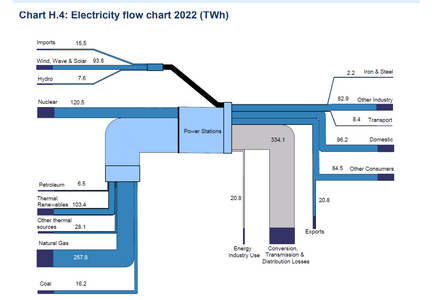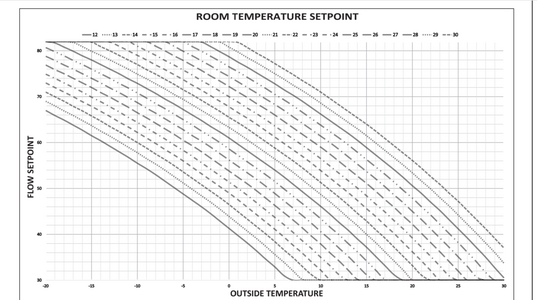This is a long and detailed posting, and I suggest you only read it all if you are interested in why the National grid and generators will not have take on the whole equivalent load when cars and gas boilers are switched to electricity.
It's sensible to wonder how the national grid will work when all the low carbon initiatives move away from fossil fuels to electricity. WIll we end up having more outages or is the National Grid resilient enough to cope or does it need to change?
Even without the carbon zero initiatives, our national consumption of electricity has always increased over time. It's hardly surprising because amongst other factors our population is increasing, and we are all using more electrical products, so the grid has always needed to expand its capacity. At least five years ago the management team of the grid made the statement that the grid will cope with the extra demand caused by EV take up. and so far it has proven to be correct.
Like most new technologies, the take up of EV's was not instantaneous, so there has been time for the grid to adjust and expand its infrastructure to meet the demand, and the same will be true for heat pump take up which was mentioned in #52.
The change over to heat pumps won't be instantaneous ether, it will be a gradual transition, so the grid will not find it has to power millions of new heat pumps suddenly overnight, there will be time for the grid (and the generators) to be adapted to cover the additional demand.
Unless you have already looked into the subject, you may not appreciate the scale of the challenge. You may think the grid needs to add as much extra capacity as the fuel energy previously used by ICE and gas boilers, but that is not the case:- It has been definitively proven that EV's and heat pumps are significantly more energy efficient than their predecessor technologies.
To show the difference it's helpful to use a common unit such as the kWh. Diesel has between 9.9 and 10.7 kWh, Petrol has between 9.5 and 9.7kWh per litre, so it's reasonable to
, Its convenient that commercial grades of petrol and diesel both have approximately 10kWh of energy in each litre, and most domestic boilers are also rated in kW's and of course we buy our electricity by the kW hour.
For example:-
It is easier to compare the difference inefficiency of a vehicle if the distance and fuel consumed is presented in the same units for this reason I will use miles per kiloWatt hours (kWh.) As the distance is already expressed in Miles, we only need to look at how to convert litres of fuel to its equivalent in kWh
There is plenty of good evidence that shows the available power from a litre of petrol or diesel has a direct equivalence in kiloWatt hours (kWh). Diesel has between 9.9 and 10.7 kWh, Petrol has between 9.5 and 9.7kWh so for a quick and simplified review of relative efficiencies I will assume both petrol and diesel produce 10kWh of power per litre, and that is actually being slightly kind to the power density of petrol!
Thus the fuel efficiency in terms of miles per kWh is calculated miles travelled divided by the litres of fuel used and then all divided by 10
m/kWh = (miles/litres) / 10
Here is a table of some comparisons
25mpg = 0.55m/kWh
30mpg = 0.66m/kWh
35mpg = 0.77m/kWh
40mpg = 0.88m/kWh
45mpg = 0.99m/kWh
You have to be doing better than 45mpg to get to at least 1mile per kWh! This is all due to the inherent inevitable inefficiency of ICE engines.
By comparison, most EV's are proven to do 2 or more miles to the kWh, with many now achieving between 3.5 and 5 miles /kWh which is a huge improvement. Even if we take a median value of say just 3kWh . what it means is the grid will only need to supply 1/3 of the energy to recharge the vehicle compared to the amount of fossil fuel the driver would have needed for their ICE vehicle.
The comparison is even greater when we look at home heating and hot water .
Even using modern condensing gas boilers, In simple terms the process is to factor the area of the radiators on the heating circuit and add the peak instantaneous hot water production to estimate the size of boiler needed. The instant hot water is the biggest factor which is why typical domestic boilers are usually between 25 and 50kW heat input. This is because in a combi the water is heated on demand and it needs a high heat input rate to produce a decent flow of hot water for both the taps and the radiators. However if you actually record how much gas is consumed over a day, it's actually far less than the burner's full bore capacity. Depending on the model of boiler you have the burner will either be turned off or fully on (Equivalent to power reduction by pulse width modulation) or the size of the flame will be modulated to match the heat input to the demand the property want's.
Ultimately the gas consumed over a day is generally a small faction compared to the boiler running at full power over the same period. I make this point becasue when switching to Heat Pump, not only is the heat source very different but also the way the system can releases the heat into the property.
Where as a condensing boiler may produce hot water at 70C, a heat pump system may only reach 60C, so to match the heat in put into a property it will need to run for longer than a condensing boiler. It may also take longer to raise the temperature of the property and in some cases radiators may need to be changed to increase their surface area so lower temperature water can transfer enough heat into the property. Some heat pump users have changed the way they use their heating system, and now keep it turned on at the same room temperature 24/7.
But the key difference between a heat pump and a combustion boiler is the heat pump does not use energy to make heat, it uses energy to move heat, usually from outside to inside for heating and some can work in reverse and actually reduce the internal temperature when needed in hot weather. A properly specified and installed unit can appear to produce more heat inside a property than the energy it consumes. In fact to show this "apparent" heat gain, Heat pump's are usually given a Coefficient of Performance figure (CoP) and for normal UK domestic installations they should be a minimum of 3 for heating but can drop to just 2 when hot water is also produced. But in ideal situations the CoP of a well installed system might reach 5! This means for every Watt of energy used to run the heat pump it might actually move 5W of heat into or out of a property
In the context of the additional load on the Grid, in practice a heat pump should need less electricity than 1/3rd of the heating fuel needed by a gas boiler to do the same amount of heating. There is a problem and that I have mentioned above it may need a change to the way you schedule your heating to achieve heat parity
To summarise compared to the fossil fuel energy needed for cars and domestic heating, the switch to electric will add some demand to the national grid, but due to the inherent efficiencies of EV's and Heat pumps the grid will not have to shoulder the same energy demand the previous technologies needed.
The grid is and will continue to change to accommodate these extra loads, but the changes are not as drastic as simply matching previous energy uses.




